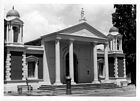The northern, or Central Market building in Castlemaine was built in 1861-62 to the plans of William Benyon Downe (the town surveyor). It was originally designed to sit between two smaller market buildings: the Eastern Market building, demolished in 1917 to make way for the Castlemaine Technical School (which was in turn converted to a supermarket and mall in the early 1990s), and the Western Market building, also demolished in 1917 and replaced in 1920 by the RSL clubrooms, which still stand.
Although some features are derived from other Australian market buildings – such as those in Sydney by Francis Greenaway (1820) and Ambrose Hallen (1831-34) – the combination of design elements and the architectural influences of the Castlemaine Market are unique within Australia. Indeed, the building’s two most characteristic features are influenced by British architectural traditions. The north front, comprising a Tuscan temple portico flanked by towers, is described by Trevor Westmore as indicating ‘an unusual and naïve regression to English Renaissance themes’ and is reminiscent of the Mistley Parish Church in Essex (Westmore though stresses that there is no evidence that Downe actually visited the Mistley Church and notes that the resemblance could be coincidental). In similar terms, Westmore suggests that the use of laminated timber ribs in the roof may be influenced by the design of King’s Cross Station in London.
Following the building’s restoration in 1973, it was used as a museum until, in 2000, it was converted to a tourist information centre and exhibition space. Today, the market building is widely recognised as being of broad architectural, social, and cultural significance. A Castlemaine Heritage Study published in 1981 states that: ‘The market building is often considered to be the symbol of Castlemaine and is a significant building on a Statewide basis’, and Trevor Westmore, in his 1992 conservation analysis, describes the market as ‘a rare remaining example of a nineteenth-century market building of high integrity’. The building is listed on both the Victorian Heritage Register and the National Estate Register. It has recently been nominated for the newly established National Heritage Register.


